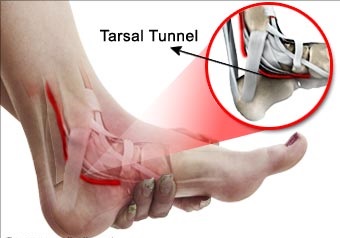
This is a condition brought about by compression, pressure, or squeezing, to the posterior tibial nerve causing harm. The tarsal tunnel is the narrow space inside of the ankle next to the ankle bones.

Causes
- People with flat feet are at a greater threat of developing the tarsal tunnel condition because the heel impact point tilts outwards with a fallen curve causing strain and pressure the nerve.
- Abnormal or enlarged structures that occupy space can compress the tibial nerve. Forms of such structures are ganglion cyst, arthritic bone spur, benign bony growths, varicose vein, and swollen tendons.
- An ankle sprain injury causes inflammation and swelling affecting the tibial nerve.
- Systemic diseases like arthritis or diabetes cause the body to be vulnerable to tibial neuropathy.
- Common with athletes who have suffered from tibial plateau fractures.
Symptoms
The symptoms vary for different individuals as some progress gradually while some people experience the symptoms almost immediately. Some symptoms aggravate with physical activity, but if the condition is long-standing, pain and tingling can be felt when sleeping.
These symptoms are evident along the tibial nerve, at the sole of the feet, or inside the ankle:
- Numbness
- Shooting pain
- Burning sensation
- Tingling sensation similar to an electric shock.
Diagnosis
If you are dealing with a tibial nerve injury or tibial nerve dysfunction, you may want to seek help from a foot specialist. Feel free to contact our office to make an appointment with our podiatrist. Our foot and ankle doctor, Dr. Ejodamen Shobowale can provide you with the care you need to keep you pain-free on your feet.
The podiatrist first examines if there is a loss of feeling by positioning the foot and tapping. If they are evident symptoms the area is pressed to determine if there is a mass present. Further imaging studies may be recommended to evaluate nerve problems. If non-surgical treatments do not work the doctor might need to conduct a nerve conduction velocity (NCV) or an electromyography (EMG) to determine the cause of the syndrome. The doctor determines if surgery is the best option to treat tarsal tunnel syndrome.
Non-surgical interventions that may be recommended include
- Letting the foot have plenty of rest to prevent further injury and encourage healing.
- Applying an ice pack on the affected area for twenty minutes, then wait for 40 minutes before applying the ice again.
- Non-steroidal anti-inflammatory drugs can be recommended to reduce inflammation and the pain.
- A cast might be applied to the foot to restrict movement in the nerve and surrounding tissue.
- Physiotherapy is recommended to reduce the symptoms of tarsal tunnel syndrome.
- Local anesthetic injections may be offered to provide pain relief and treat inflammation.
- Orthotic gadgets such as custom shoe additions may be prescribed to confine unnecessary motion.
- Supportive footwear may be advocated.
- Braces might be fitted especially for flat-footed people to relieve pressure off the foot.
If the condition is not treated, it results in irreversible nerve damage leading to difficulties in walking. If you have any questions, please feel free to contact our office located in Houston, TX. Our Houston, TX office can handle all of your foot and ankle issues. We will provide you with the latest diagnostic and treatment methods for treating all foot-related stress fractures.
Frequently Asked Questions
How do you treat tarsal tunnel syndrome?
Treatment for tarsal tunnel syndrome typically includes rest, ice application, and anti-inflammatory medications to reduce swelling. In more severe cases, physical therapy, corticosteroid injections, and custom orthotics may help. Surgical intervention is considered for persistent cases that don’t respond to conservative treatments.
What is the difference between tarsal tunnel and neuropathy?
Tarsal tunnel syndrome is a specific type of neuropathy that occurs when the posterior tibial nerve is compressed as it passes through the tarsal tunnel in the ankle. Neuropathy, on the other hand, refers to general nerve damage or dysfunction, which can be caused by various factors, such as diabetes, and affects nerves throughout the body.
What is the best exercise for a tarsal tunnel?
Stretching exercises for the calf and foot muscles, along with strengthening exercises for the ankle, are often recommended. Calf stretches, toe curls, and ankle mobility exercises can help relieve pressure on the tibial nerve, improving flexibility and reducing discomfort.
Is heat good for tarsal tunnel syndrome?
Heat can provide temporary relief for tarsal tunnel syndrome by relaxing muscles and improving blood flow. However, it should be used with caution, as excessive heat could aggravate inflammation. Ice therapy is often preferred for reducing swelling and inflammation, especially during flare-ups.